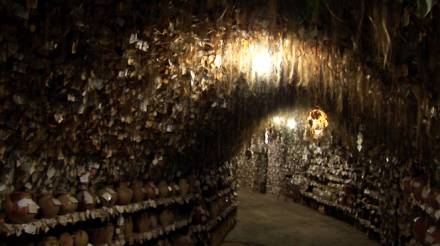
image: The Hair Museum, Cappadocia, Turkey. (Credit: Bobby Niven)
Central Station catches up with Bobby Niven, who was awarded our Member Fund back in June, to discuss his documentary Chez Galip about the eerie Hair Museum in Cappadocia, Turkey.
When did you first hear about the Hair Museum in Turkey?
I went to Istanbul to do a residency in 2008 and from there I took an overnight bus to Cappadocia to do some drawings of the volcanic landscape. I remember picking up a leaflet about potters in the town of Avanos and in there I found an article about the hair museum, so the next day I went to have a look.
The museum is set in a cave below the workshop of a potter called Galip. In 1979 Galip had the idea of collecting women’s hair, the purpose of which was to raise course participation numbers for the pottery workshops he was running. Galip takes a cutting of hair from women that visit his workshop and attaches it along with a post-it note with their name, phone number and address to the wall of the cave. Every six months 10 addresses are chosen at random from inside the cave, the women are then contacted to announce that they have won a trip to stay in his guesthouse and participate in the pottery workshops for free.
What was it about the place that you wanted to explore through film?
Last winter I made a film up in the extreme north of Scotland with Martin Clark and Cara Connolly. We were making an observational documentary about Hermit’s Castle and the story of its creator David Scott (see image below). The process of working with film, the intensity of working collaboratively and the excitement of the journey was a great experience for me. Just after shooting Hermit’s Castle I was invited to do a show at Sierra Metro in Edinburgh and so I immediately started thinking about potential subjects for another film. Then I had the idea to travel to Turkey and make a film about the hair museum and its creator Galip. The exhibition would then become a comparative study of two quite extreme stories about two very different characters building something absurd in two geologically incredible landscapes. What I wanted to explore through film was the relationship between structure and landscape and the potential for the medium to question the reasoning and psychology behind the creation of these absurd structures.
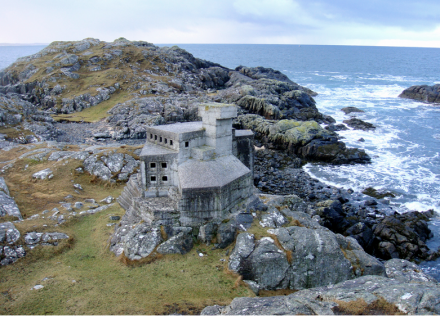
Image: Hermit’s Castle, Scotland. (Credit: Bobby Niven)
How many days were you there shooting for? How did the shoot go?
We were away for 11 days in total, four of which were spent traveling leaving us only 7 days in which to collect the footage. We had to put in some long shifts, shooting tracking shots in the cave during the day and doing interviews in the evening. There is an abundance of material to film in Cappadocia. I was interested in capturing the visceral qualities of the hair, the clay, the soft curvaceous landscape and the sound textures of these materials set within the acoustics of the enclosed caves and valleys.
How did the experience compare to your expectations? Did anything come from the experience that was particularly surprising to you?
The sounds Cara collected from inside the pot as it was being thrown were amazing. The potter’s workshop is a real orchestra of different sounds through the wedging of the clay, the spinning of the kick wheel, the contact between hand and clay, the breathing fluctuations of the potter and the air movement out of the pots as the potter brings in the neck. It was really interesting to observe the reactions of the potters as they listened back over the sound recordings.
I had originally planned on interviewing Galip when he was throwing as a way to avoid the direct eye contact of a conventional interview set-up, but what I didn’t appreciate was the potter’s need for silence and concentration when throwing. The quality of the sound in the room as we filmed him throwing was incredibly vivid, allowing you to observe this concentration and connection between hand, brain and clay. We also recorded the sound of ceramic instruments being played by local musicians who take this connection between clay and sound and introduce rhythm and lyrics recalling old folk songs from the area that are so old they are without author. There seemed to be a strong relationship between potter and musician with both taking pleasure in the other’s craft.
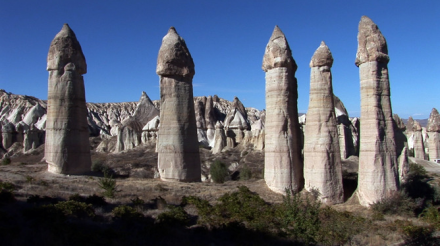
Image: Love Valley, Cappadocia, Turkey. (Credit: Bobby Niven)
What was the most memorable part of the shoot?
There are a few. Diarrhea, good food, the generosity of the hosts, the Turkish humour, the entertainment of working collaboratively… The most intense experience had to be filming in the underground city which was insane. Walking hunchbacked down through eight stories of underground labyrinth, descending further and further into a network of rooms built by Christian communities as hideouts during the Arab raids. It brought on an unnerving sensation of excitement combined with the claustrophobia of descending into a stone hell.


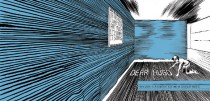

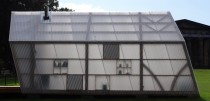









Comments